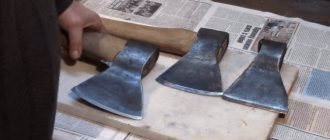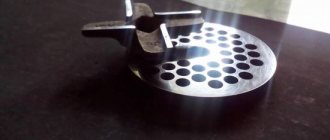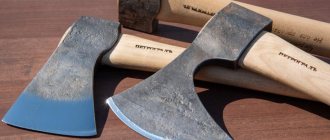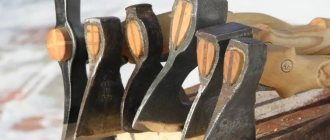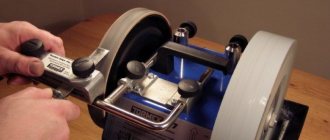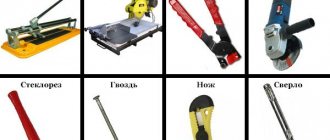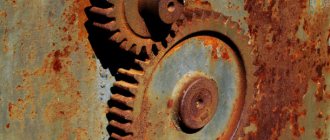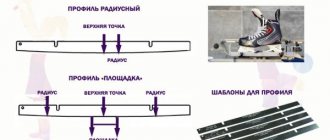The condition of the working tool determines the quality and efficiency of its use. In this regard, the ax places increased demands, since the specifics of its use involve high loads on the cutting edge. It produces not cutting, but chopping movements, and constant impact quickly destroys the sharpening. However, if the cutting edge is formed correctly, taking into account the specifics of the work and the characteristics of the material being processed, the period of effective work between sharpenings can be significantly increased. Let's consider this issue in more detail.
Design and types of product
The design of the ax has changed little over the millennia. The design of all varieties includes the following parts:
- steel blade with a spine;
- wooden or plastic handle - ax handle;
- metal or wooden wedges or other system for attaching the blade to the handle.
The blade is made from high-quality tool alloys with a carbon content of more than 0.7%.
According to their purpose, the following types of axes are distinguished:
- Plotnitsky (universal). The main purpose is carpentry work, but with such an ax it is possible to fell a small tree and chop firewood
- Cleaver. The purpose of a heavy tool with a long handle is to chop wood in large volumes. The shape of the blade prevents it from getting stuck in the log.
- Lumberjack. Optimized for logging: tree felling and delimbing. Weighs up to 2 kg.
- Tourist. Lightweight, small-sized hatchet for universal use. Purpose: to chop dead wood, spruce branches for overnight stays, tent stakes, etc.
- Multifunctional. The butt is made in the shape of a pickaxe, hammer head, or nail puller. Used by roofers and concrete workers, amateur builders for limited volumes of various works.
Carpenter's ax
Tourist ax
There are also highly specialized varieties - for cutting meat carcasses, fire engines, used in historical reconstructions, etc.
General information
An ax is a special tool that is used for processing or cutting wooden elements. This device consists of three elements: a sharpened blade, a securing wedge and a handle. The last element is usually made of wood. The blade is made from various types of steel, which contains more than 0.7% carbon. This condition must be met. Both special types and ordinary ones are used as metal. These two types of metals differ in the amount of impurities they contain. In the first, their higher content is observed. When producing metal, phosphorus, sulfur, oxygen, etc. are usually added. Sharp objects made from ordinary metals have a short service life. Therefore, when choosing an ax, you should pay attention to the markings. The letter A means that the metal is of the highest quality and will last longer.
All machines are equipped with the latest safety systems to ensure maximum operator safety. The rotating spiral blade allows you to cut single or thick sheets up to 15 sheets. Manual or electric, used by copy centers, photographic centers, technical offices and surrounded by elliptical machines or plotters.
Used in the office sector for cutting up to 40 sheets thick. Models vary depending on: useful for the cutting edge; Paper press, manual or automatic; The presence or absence of a front panel to perform a sequential cut. Cuts thick paper. Machines, manual or electric, differ according to: maximum cutting size; maximum thickness; Setting the cutting size, measurement adjustment type, presser paper block stopped the paper, manual, electric or hydraulic, jockey movement, blade release.
Before purchasing a tool, you also need to determine its destination.
A properly selected ax helps save time and effort, as well as perform the task efficiently.
What determines the method of sharpening an ax
It is possible to sharpen a tool using several methods, giving the tip different shapes and angles. The choice of method is determined by the following parameters:
- Type of wood processed. Stiffness, length and orientation of fibers, their twist, general knotiness.
- Wood moisture content. To split wet wood, a large blade entry depth is required.
- Type of work to be done. To trim a log, a sharper angle is required. To chop firewood, the slope must be greater.
- The steel from which the blade is made. A stronger one is more difficult to sharpen, but it will also keep its edge longer.
No less important parameter than the angle is the width of the chamfer (for trimming logs or bevels). It should be sufficient so that the ax fits well into the tree and does not bounce off it.
Blade shapes
On new tools, the ax is usually sharpened at the desired angle and with a good chamfer width. If the tool works, the bevels will have to be updated.
The process of sharpening an ax
Sharpening an ax properly requires attention and concentration.
You will need:
- a set of abrasive stones with different grains;
- a piece of rough cloth;
- measuring stick or protractor;
- water;
- The belt is usually made of genuine leather.
First you need to measure the current sharpening angle. This is done by applying a measuring block. The block is made with a bevel equal to the angle at which you decide to sharpen the tool.
to sharpen an ax, place it on a flat base (table, stool) and begin to draw a block along the blade, describing half rings. The block should be held at a sharpening angle. Coarse abrasive is used to restore the required slope and width of the chamfer. The operation is repeated on the other side of the blade.
Next, you should take a block with a medium grain and sharpen it on both sides. And finally, it’s the turn of the third, smoothest sharpener - it is used to remove burrs and the smallest irregularities. The surface of the chamfer should be smooth to the touch.
Attention! You should check the surface by running your finger only from the butt to the tip.
The testamentary operation is editing on a tense leather belt.
During work, the ax and abrasive bars must be moistened with water. Dust and small metal particles are removed with a piece of cloth.
During initial sharpening and in cases where the ax has become very dull, experts recommend removing it from the ax handle. And the tilt will be easier to maintain, and the handle will not get in the way.
Professionals use special sharpening devices - electric sharpening machines. There are adjustable stops for the sharpened tool, allowing you to sharpen it at a given angle.
Using a sharpener for straightening cutting devices
An electric sharpener is used to sharpen various tools used in carpentry work: chisels, chisels, etc. To make the cutting edge sharp, use a special fine-grained stone and a low-speed sharpener.
When working with metal structures, where a lot of drilling is required, there is a constant need to sharpen metal drills. In this case, the master needs to know at what angle the drill is tucked. Each material has its own hardness. Approximate values of sharpening angles for various types of materials are given below.
To properly sharpen a drill, various devices are used to hold it at a certain angle to the abrasive wheel. What such devices look like is shown in the photo below.
It would seem that the simplest operation is to sharpen an ax. It is difficult to overheat, since it has a significant mass of metal. But even here difficulties may arise.
- For each operation performed with an ax, a certain sharpening angle is required. So, for working with fresh raw wood it is 20 degrees, and for trimming dry firewood - 30 degrees.
- Sharpening an ax on an electric sharpener overheats the metal of the blade, which leads to increased fragility. When working, such an ax will very quickly become dull again.
- You should sharpen the ax at low speeds and eliminate the beating of the abrasive as much as possible.
- Use a water-cooled electric sharpener or constantly immerse the ax in cold water.
- You need to sharpen the ax by holding its blade towards the rotation of the abrasive disc. The butt should be located at an angle of 45 degrees relative to the circle.
When working with an electric sharpener, you should follow safety precautions. Do not use the sharpener without protective covers: the abrasive wheel may fly apart and cause injury during operation. It is also necessary to use eye protection against scale and sand.
Ax sharpening angles
The sharpening angle of the ax is chosen based on the characteristics of the work to be done. To trim logs or posts, you need to sharpen a very sharp angle - up to 20°.
The slope of the bevel for the cleaver is selected based on the mechanical properties of the wood. For fragile spruce it can be smaller, but for very dense and hard acacia, on the contrary, it can be blunter.
Sharpening angle
Precision work - for example, selecting grooves and tenons - is performed with an angle of 15-20°. This value makes it possible to carry out both preliminary rough processing and fine adjustment of the part to a given size.
Ax chamfer width
The width of the chamfer corresponds to the distance from the axis of the blade to its side surface. This parameter determines both the sharpness of the tool and the service time until the next sharpening. Sharpening an ax with the correct bevel is quite quick and easy.
Correcting the dimensions of the chamfers is a more complex operation and will require a lot of time and effort. To change the width of the chamfers, it is necessary to remove excess metal.
Historically, axes damaged by long work or corrosion, which had lost part of the metal in the chamfer area, were restored by a blacksmith using the method of partial reforging. The weight and dimensions became smaller, but the geometric parameters and functionality of the instrument were restored; it was enough to sharpen it again.
Double beveled ax
Axes made from low quality metal wear out quickly and lose their bevel shape. In this case, you should sharpen the tool asymmetrically: - one chamfer is made at 15°, and the other at 25°.
Standard errors
There are several common mistakes when sharpening:
- Overheating of the material when working on an electric grinder. This leads to a change in the internal structure of the steel and, as a consequence, to a loss of strength and elasticity. At the same time, the wear resistance, sharpness and other performance qualities of the tool are significantly reduced. To avoid overheating, you need to periodically moisten the abrasive with water or other coolant.
- An attempt to sharpen an ax on a grinder. When holding the grinder in your hand, beating cannot be avoided, and the blade will constantly move to the side. In such conditions it is impossible to talk about observing any angles. Here it would be nice to just hold in your hands a dangerous tool that is flying to the sides. Attaching an angle grinder to the machine will improve the process, but not much. The problem of lateral slip will not go away.
- The desire to sharpen a blade on old equipment with a worn-out sharpening wheel. Axial runout and unevenness of the abrasive surface will not allow you to sharpen the ax efficiently, in compliance with the required angles and width of the chamfers.
It is better to spend more time sharpening the tool by hand than to use low-quality or unsuitable equipment.
How to properly sharpen a carpenter's ax
To work on a grinding wheel, you will need to make a block with a bevel corresponding to the sharpening angle. They are used as a support for the tip.
The blade mounted on the block should be moved in a circle until the chamfer is completely adjacent to the surface of the sharpener. This method is quite labor-intensive and requires attention and perseverance.
Experts recommend another method. It will require:
- wire brush and rust converter liquid;
- sandpaper – hard, medium and velvet;
- safety glasses or clear face shield;
- polishing paste type GOI;
- a piece of felt fabric;
- bench vice;
- set of files;
- template or measuring ruler;
- double-sided grinding wheel;
- mineral lubricating oil;
- a piece of technical wax.
To sharpen an ax, you should perform the following operations:
- Clean the blade from rust and dirt.
- Clean it with coarse sandpaper.
- Sand with medium-grit sandpaper.
- Polish the surface with GOI paste.
- Secure in a vice.
- Use a brute file to sharpen the chamfer, bringing it to 12 mm. This will correspond to an angle of 25°.
- Brush away dust and sawdust.
- Perform final sharpening with a double-sided sharpener on the rough side, wetting the blade with liquid.
- Bring the edge to perfection with the soft side of the sharpener.
Sharpening an ax with a file
To complete the job, you need to apply a corrosion inhibitor liquid.
Second phase
Before sharpening the axe, you need to use a permanent marker to indicate the angle at which you will renew the sharpening. You need to draw on top of the blade. After this, secure the ax so that it is against the abrasive stone. The circle should rotate towards the axe. Now, using a special nut, adjust and then fix the sharpened angle. After this, you need to lower the blade to the sharpening stone. The angle is checked as follows.
It is enough to turn the sharpening wheel by hand several times with the machine switched off. If your adjustment is done correctly, the turning disc will completely erase the marker-colored surface on the blade. If the angle is too small, the painted blade will be erased only from the very edge. And vice versa, at a large angle, the zone closer to the butt part will be erased. This means that you will have to repeat the angle measurement procedure again until you reach the desired value. Some home craftsmen set the angle using a template specially made from tin. It is applied at a certain angle to the blade that needs to be processed, and then the deflection angle is determined. It is marked with appropriate marks.
How to sharpen an ax using an electric sharpener
An electric sharpener is a machine with an electric drive. Its main working body is the abrasive wheel. The surface used is the generatrix of a cylinder, which eliminates lateral movement of the tool being sharpened.
In addition to the sharpening machine itself, you will also need:
- double-sided hand sharpener;
- polishing paste;
- marker;
- protective equipment: glasses, gloves, thick overalls and shoes;
- goniometer device
Before you start sharpening, you should put on glasses and gloves. Next perform the following operations:
- Paint over the existing chamfer with a marker.
- Secure the ax in the machine's mounting fixture.
- Bring the tip to the grinding wheel.
- Set the sharpening angle using a protractor and an adjusting nut.
- Turn the grinding wheel by hand.
- Check the bevel - if the angle is set correctly, the ink will be completely erased at the point of contact with the stone.
- Adjust the angle as necessary.
- Only now should you TURN ON the sharpener.
- Sharpen the chamfer until all nicks and nicks are leveled.
- Level the working surface of the abrasive with a hand sharpener.
- Bring the sharpening to perfect condition.
- Remove the tool from its mounts, lubricate a leather or felt wheel with polishing paste and polish the bevels of the tip.
- Apply anti-corrosion fluid.
Sharpening an ax with an electric sharpener
During operation, be sure to periodically moisten the surface of the abrasive with water or oil. The blade also needs to be wetted regularly. This will help avoid overheating of the metal and unwanted changes in its structure, leading to a decrease in strength and other performance qualities.
If you need to change the sharpening bevel, you should skip the operations with a marker and manually turning the disk and immediately set the angle using the protractor.
An electric sharpening machine allows even the least experienced sharpener to achieve ideal angles and bevel widths. However, high-quality equipment is not so cheap. It will give an economic effect when there is a large number of sharpened tools and the frequent need for sharpening them.
Necessary equipment
The device used to maintain the ax in shape may differ in structure, complexity of operation, and price. A special sharpener for an ax allows you to solve the problem quickly and without much physical difficulty, but in this case it is important to monitor whether the cutting blade is overheating, and you will also have to pay a decent amount. This explains why the sharpening machine is more often used by professionals who require it on an ongoing basis. For home use, an abrasive wheel that locks at the required angle is more suitable.
You should also make a stencil to understand what condition of the blade you should strive for. To do this, the required angle is cut on a small sheet of tin, which is then applied to the cutting blade and drawn with a marker.
